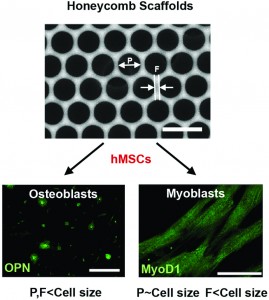The ability for a stem cell to differentiate into a specific cell type depends on the cell’s surrounding microenvironment. Variables such as substrate stiffness, presence of certain growth factors, fluid flow, and extracellular matrix composition in the cell culture environment all play a role in the cell’s ability to differentiate. Additionally, there is great interest in studying the effects of surface topology on stem cell differentiation in vitro to more accurately mimic the in vivo microenvironment. Using various micro-fabrication technologies, 2D and 3D substrates with varying topographic features including grooves, pits, pores, and posts can be fabricated and tested with cells to evaluate cell response.
Researchers at Tohoku University in Japan have fabricated “honeycomb” topological substrates to regulate the differentiation of mesenchymal stem cells. The substrates are manufactured using a chloroform solution of polystyrene and an amphiphilic co-polymer, poly(N-dodecyl acrylamide-co-6-acrylamidehexanoic acid), or dioleoylphosphatidylethanolamine (DOPE). The solutions were cast on a glass slide and exposed to a flow of humid air to generate polystyrene films that resemble honeycomb from a beehive. The honeycomb substrates had varying pore size and strut width depending on the chloroform evaporation time.
After obtaining four different honeycomb films with varying pore size and strut width, human mesenchymal stem cells (hMSCs) were seeded on the surfaces to evaluate cell differentiation into osteo-specific (bone) and myo-specific (muscle) cells. To determine the cell differentiation state, cells were stained with osteoblast and myoblast markers, osteopontin and MyoD1, respectively.
Interestingly, when both the pore size and strut width were smaller than hMSC size, cells showed globular morphologies and increased expression of osteopotin (consistent with osteo-specific differentiation). On the other hand, when the pore size was the same size as hMSCs, the cells expressed MyoD1 and had elongated morphologies (consistent with myo-specific differentiation). Given the promising morphological and staining results, further studies are required to fully characterize the molecular mechanisms of the differentiation process.
This study demonstrates that geometries of honeycomb topographical substrates may have a direct influence on stem cell differentiation. Surface topology of biomaterial surfaces must be taken into account for future designs of cell culture environments for stem cell differentiation studies.
Honeycomb-shaped surface topography induces differentiation of human mesenchymal stem cells (hMSCs): uniform porous polymer scaffolds prepared by the breath figure technique
Takahito Kawano, Madoka Sato, Hiroshi Yabu and Masatsugu Shimomura
Biomater. Sci., 2014, Advance Article DOI: 10.1039/C3BM60195A
Brian Aguado is currently a Ph.D. Candidate and NSF Fellow in the Biomedical Engineering department at Northwestern University. He holds a B.S. degree in Biomechanical Engineering from Stanford University and a M.S. degree in Biomedical Engineering from Northwestern University. When he’s not in the lab, Brian enjoys traveling, cooking, swimming, and spending time with family and friends. Read more about Brian’s research publications here.
To keep up-to-date with all the latest research, sign-up to our RSS feed or Table of contents alert.











